
Project Processes
Inhalte von Prof. Dr. Kurt Englmeier
All projects, from technology to architecture, are composed of processes. Recall that phases are unique to each project and that the goal of the phase is to conclude with a specific, desired result. The completion of phases is the end of the project, culminating in the creation of a unique product, service, or result. Processes are a series of actions with a common, parent goal to create a result. Projects are completed through project processes
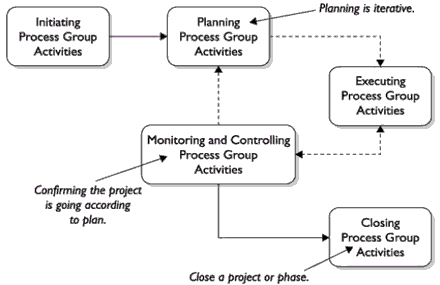
Project Management Process Groups
● Initiating The project or project phase is authorized.
● Planning Project objectives are determined, as well as how to reach those objectives with the identified constraints, project scope, schedule, costs, quality demands, and risks.
● Executing The project is executed utilizing acquired re-sources.
● Monitoring and controlling Project performance is mon-itored and measured to ensure the project plan is being im-plemented to design specifications and requirements.
● Closing The project, its phases, and contracts are brought to a formal end.
Process groups
The process groups are not solo activities. The groups are a collection of activities that contribute to the control and implementation of the project management life cycle. The output of one process group will act as input for another process group. Process groups may overlap other process groups.
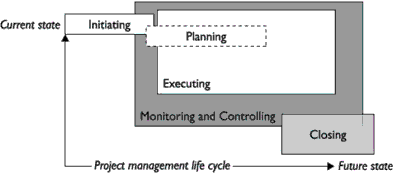
Not only will process groups overlap, but some process groups may be repeated based on the activities within the project. When you're managing a multiphase, large project, you'll even repeat initiating and closing. Most projects, because of the cyclic nature of the project management work, will at least repeat planning, monitoring and controlling, and executing processes throughout the project. Processes may be iterative throughout the project. A project's management flows through project boundaries and iterations of processes.
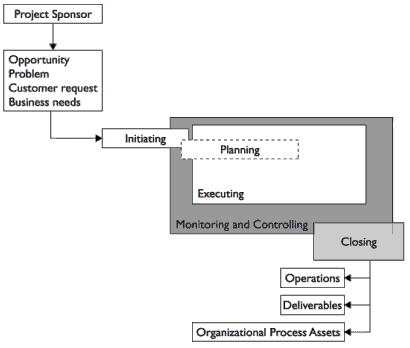
Initiating: Identifying Needs
A project is generally called upon to provide a solution to a problem or to take advantage of an opportunity.
● Reducing costs
● Increasing revenues
● Eliminating waste
● Increasing productivity and efficiency
● Solving a business or functional problem
● Taking advantage of market opportunities
This is just a short list. Countless other needs can be addressed through project plans.
Initiating: Feasibility Study
A feasibility study is conducted to prove a problem actually exists, document the opportunities at hand, and then determine if a project can be created to resolve the problem or take advantage of the opportunity cited. A feasibility study may also look at the cost of the solution in relation to the possible rewards gained by its implementation.
Initiating: Business Needs
The business needs will examine the problem, opportunity, and solution to see how the potential project and its expected outcome fit within the realm of the business vision and goals.
- Business (Vision, Strategy)
- Funcional (Tactics)
- Operationel (Technical achievements)
Initiating: Product Description
The initial product description will describe what the expected outcome of the project is to be. This may be a service, a product, or even a description of the desired future state. The initial product description does not have to be an exact specification document of what the project will create, though in some instances it may. Typically, the product description describes the high-level solution or realized opportunity that the project will accomplish.
Initiating: Project Charter
The project charter authorizes the project, officially naming the project manager and authorizing the project work. Yes, it's true that the project manager and the project management team may write the project charter, but the charter's approval and funding are outside the project's boundaries. In others words, the project charter should be approved and funded by an individual within the organization who has the proper authority to approve the project manager, the needed funds, and the resources that will be utilized within the project work.
In order to create a project charter, the project management team requires the following:
A contract, if the project is being completed for another entity.
Business case defining the project purpose to capture an opportunity, solve a problem, or other reason why the project is authorized.
A project statement of work identifying the project's goals
Enterprise environmental factors, such as the organization's structure, culture, and relevant regulations and standards
Organizational process assets, including policies, standard project management forms, templates, and organizational procedures that affect the project work
Initiating: Project Stakeholders
Stakeholders are the people, groups, and organizations that are affected by the project's existence and outcome. Stakeholders have varying roles in the project, such as contributing project information, paying for the project, working on the project, or receiving and using the project deliverables. A stakeholder management strategy is needed, as you'll want to communicate accurately, timely, and effectively with both positive and negative stakeholders. The stakeholder management strategy is directly linked to the project communications management.
Planning Process Group
The planning processes are iterative in nature; a project manager does not complete the planning processes and then move on to other activities within the project, never to return. Throughout the project, the project manager and the project team will be returning to the planning processes as often as needed. Changes to the project scope, new risks, challenges, and issues all can send the project back to planning.
Planning Processes
Collect and Document Project Requirements
As part of planning, the stakeholders' expectations and requirements must be analyzed. The stakeholders' expectations must be documented, prioritized, and balanced between competing objectives. Within large or highly technical projects, planning can also
be known as rolling wave planning. Rolling wave planning focuses detailed planning on the immediate activities of the project rather than on remote, future activities that may be affected by the outcome of the direct project results.
Creating the Project Scope
Project managers must have a scope management plan that defines how the project scope will be defined, what changes will be allowed, and how the scope can be controlled. The scope management plan also defines the approach to create the work breakdown structure. The scope statement is a document that describes the work, and only the required work, necessary to meet the project objectives. It is based on the project charter, identified requirements, and organizational process assets. The scope statement establishes a common vision among the project stakeholders to establish the point and purpose of the project work.
Creating the Work Breakdown Structure
The work breakdown structure (WBS) is an organized collection of the project-deliverable components to be created by project work. The project manager cannot complete this activity alone. The input and guidance of the project team is required, as they are the individuals closest to the work and will be completing the actual activities within the project phases. The WBS is not a list of activities—it's a deliverables-oriented decomposition of the project. The activity list is based on the identified deliverables within
the WBS.
Creating the Activity List
The activity list, as I mentioned, is based on the WBS. The project manager and the project team will decompose the project scope statement into deliverables in the form of a WBS. The smallest item in the WBS is called a work package. Each work package is related to an activity or set of activities that will create the deliverables. The sum of all of the activities will create all the work packages, which in turn satisfies the project scope.
Creating the Activity List
This planning process also documents the attributes of each activity in the activity list. The project team should document any risks, issues, or concerns about the nature of the activity to prevent problems during project execution. The project manager and the project management team will also identify the project milestones with the activity list. A milestone is a timeless event that signals project progress. By identifying the milestones with the activity list, it is clear which activities will contribute to the mile-
stone. It's also useful, as milestones are typically created by the completion of a project phase. Now the project manager and team can see the work required in each phase of the project.
Creating the Network Diagram
Once the activity list has been created, the project team can sequence the activities in the order in which the work should be completed. The network diagram, also called the project network diagram (PND), illustrates the flow of activities to complete the project and/or the project phase.
Estimating Project Resources
Resources are people, equipment, facilities, and materials that are needed in order to complete the project activities. You'll need to know what resources are needed in order to do accurate time and cost estimates later in planning.
Developing the Project Schedule
The project schedule is dependent on the creation of the WBS, the PND, and the availability of the resources. Based on when the resources, the project team, and other required resources, such as equipment and facilities, are available, the schedule can be determined. In many instances, the project must be scheduled according to time constraints. Using the constraint of a deadline on the project, all activities must be scheduled, from the project's start to its completion, to ensure the project can finish on time. The critical path is the chain of activities within the PND that cannot be delayed without delaying the project end date.
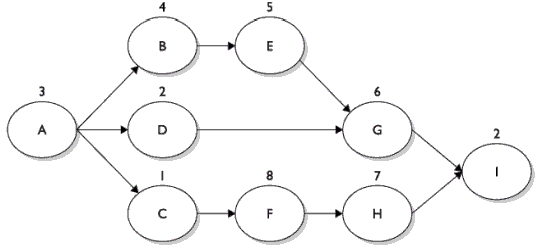
Completing Estimates
Time and cost estimates are completed within the planning process. Time estimates reflect the amount of time to complete each activity within the WBS. Once the estimates are mapped to the PND, an accurate estimate of how long the project will take to complete may be created.
Planning for Project Financials
The project manager and the project team need to create a cost estimate for the project work. The project budget is the cost of the project, cash flow projections, and how the monies will be spent. The project budget should cover the cost of the team's time, facilities, and all foreseeable expenses.
Planning for Project Financials
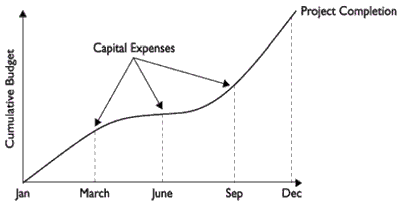
Creating a Quality Management Plan
The quality management plan details how the project will map to the organizational quality policy—for example, ISO 9000 or Six Sigma specific actions. The plan will provide specifics on how the project team will meet the quality expectations of the organizational quality assurance (QA) program. The quality management plan also sets the guidelines for how the project will adhere to quality control (QC) mechanisms and ongoing quality improvement.
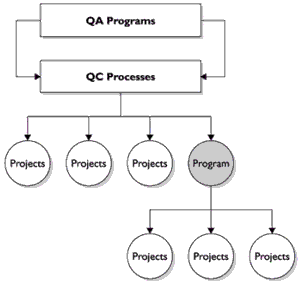
Planning for Human Resource Needs
The project team completes the project work, while the project manager relies on the project team to do several tasks, including the following:
● Completion of the project work
● Providing information on the work needed to complete the project scope
● Providing the necessary accuracy in project estimating
● Reporting on project progress
Creating a Communications Management Plan
The communications management plan determines who needs what information, how they need it, and when it will be delivered. The plan specifies team meetings, reports, expectations for reports, and expectations of communication among team members. The communications plan must account for all needed communications within the project.
Completing Risk Management Planning
Risk can be both good and bad. Generally, risk is a perceived threat (or opportunity) to the completion of the project. Every organization has a different approach and attitude towards risk. Risk management planning defines the project manager's obligations to acknowledge, document, research, and plan for risks within the project. Many organizations use a predefined risk management plan that all project managers must adhere to.
Planning for Project Procurement
Chances are that a project will need to purchase materials and services and hire contractors to complete the project work. The purchase of a thing or service requires the project manager to follow the organizational policies and procedures for procurement. This can include finding qualified vendors, requesting quotes or proposals, and reviewing those proposals for the best vendor. The procurement management plan will guide the project manager through the processes of selecting vendors, the appropriate procurement documents, and contract selection and administration.
Officially Launching the Project Work
Planning is an iterative process. The result of planning is to allow the project work to begin. Once the project has reached a collective state of agreement between the project manager, management, the project team, and the customer, the project execution is officially allowed to begin. Bear in mind that planning does not have to be 100 percent complete for project execution to begin. Planning can move through iterations, as appropriate, based on the project work, conditions, and demands of the organization.
Execution Processes
The executing processes allow the project team to perform the project work. It is the execution of the project plan, the execution of the vendor management, and the management of the project implementation. The project manager works closely with the project team in this process to ensure that the work is being completed and that the work results are of quality. The project manager also works with vendors to ensure that their procured work is complete, of quality, and meets the obligations of the agreed-upon contracts.
Variances are the difference between what was planned and what was experienced. Common variances are time and cost estimates, risk impacts, risks that were not identified but came into planning, and the availability of project resources. Some variances can spur change requests that will cause the project management plan to be changed, the scope to be broadened or reduced, or, in some situations, cause the project to be rebaselined.
Directing and Managing Project Execution
This is the business of getting the project done. The project team executes the work as defined in the project management plan, and the project manager manages the work. This also includes the management of the organizational and technical interfaces the project manager must interact with to ensure that project work flows smoothly and as planned. The bulk of the project time and budget are consumed during project execution.
Mapping to Quality Assurance
As the project work continues, the project team and the project manager will need to verify that the project work results are mapping to the organization's quality assurance program as described in the quality management plan. Failure to adhere to the quality assurance program may result in penalties, project delays, and work that needs to be redone, as shown in the following illustration.
Acquiring and Developing the Project Team
There needs to be a project team in order for the project to be completed. Based on the organizational structure, the project manager will recruit the project team or the project team will be assigned to the project manager. The project manager must work with the project team members to ensure that their level of proficiency is in line with their obligations on the project. This may involve classroom learning, shadowing among project team members, or on-the-job training. The success of the project work is dependent on the project team's ability.
Managing the Project Team
The project team completes the work, and the project manager ensures that they do so according to the plan. The outcome of managing the project team includes the following:
● Change requests
● Corrective actions
● Preventive actions
● Project management plan updates
Dispersing Project Information: Information must be disseminated according to the communications plan.
Manage Stakeholder Expectations: The project manager needs to address the stakeholders concerns, needs, and perceived threats about the project.
Managing Procurement Activities: This part of procurement involves making a decision as to which identified vendor will be the source of the service or good being procured.
Monitoring and Controlling
The monitoring and controlling processes are the activities that ensure the project goes according to plan and identifies the actions that need to be implemented when evidence proves the project isn't going according to plan. Specifically, the controlling processes verify project work and the response to that work. In addition, the project manager must work to control the predicted cost and schedule of the project. Variances to the cost and schedule will affect the project's success.
Managing Integrated Change Control
Integration management is the control of the project's components and how each part of a project may affect its other parts. For example, a proposed change to the project scope may affect the project schedule, time, cost, quality, risk, communications, human resources, and even procurement issues.
Providing Scope Verification
Scope verification is the process of verifying that the work results are within the expectations of the scope. It is typically done at project phase completion, where the customer formally accepts the product of the project work. Should scope verification fail, corrective actions are generally needed to bring the work results back into alignment with the expectations of the project scope.
Implementing Scope Change Control
The project manager must follow the change management plan to ensure inappropriate changes to the project scope do not occur. This includes scope creep that the project team may be creating on its own accord—for example, the project team members may be making additional adjustments to the equipment they are installing in a project, even through the project scope does not call for the additional adjustments.
Managing Integrated Change Control
Integration management is the control of the project's components and how each part of a project may affect its other parts. For example, a proposed change to the project scope may affect the project schedule, time, cost, quality, risk, communications, human resources, and even procurement issues.
Enforcing Schedule Control
Schedule control requires constant monitoring of the project's progress, approval of phase deliverables, and task completion. Slippage must be analyzed early in the project to determine the root cause of the problem.
Managing Cost Control
Controlling the project's cost requires accurate estimates and then a check and balance against those estimates.
Ensuring Quality Control
Quality control (QC) measures work results to determine if they are in alignment with quality standards.
Ensuring Performance Reporting
Performance reporting stems from accurate measurement by the project team, proof of work completion, and factual estimates.
Completing Performance Reporting
As the project moves towards completion, the project manager and the project team must measure the project performance. Performance reporting includes the following:
● Status reports
● Progress measurement
● Forecasting
● Performance reports
● Recommended corrective actions
Monitoring and Controlling Project Risks
Risk management requires risk ownership and monitoring by the project team members. As activities in the project network diagram (PND) are completed, the project manager and the risk owners must pay special attention to the possible risks and the mitigation plans that may come into play.
Project Closing
Closing Vendor Contracts
At the completion of a project or project phase, the vendor contracts must be closed out.
Closing Administrative Duties
When the project is completed, the project manager must finalize all reports, document the project experience, and provide evidence of customer acceptance. The project manager will create a final report reflecting the project's success or its failure. The project manager will also provide information reflective of the project product and how it met the project requirements, and then will complete the lessons-learned documentation.
CategoryProjectIntegrationManagement
Diese Seite wurde noch nicht kommentiert.





